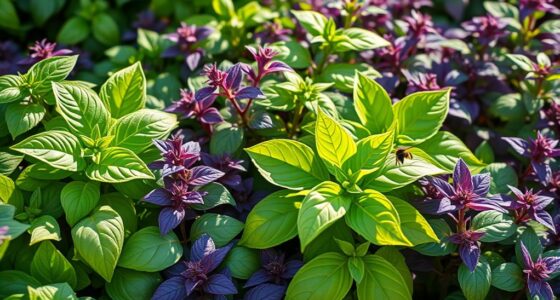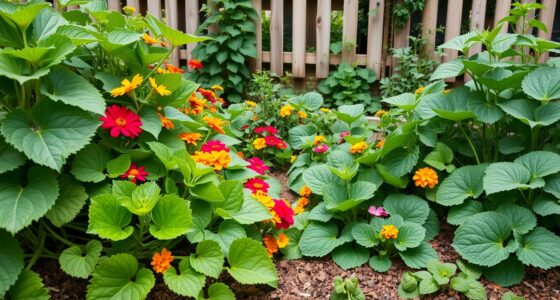Imagine stepping into your backyard as the sun begins to rise, where the vibrant colors of ripe blueberries burst forth against lush green leaves. These magnificent plants, adorned with fragrant blooms and yielding sweet, juicy berries, invite you to explore the world of gardening. You may not realize it, but the key to elevating your blueberry experience lies in understanding blueberry companion plants. By choosing optimal blueberry garden companions, you can enhance the vibrancy and harvest of your garden. Companion planting with blueberries not only maximizes fruit production but also improves soil health and keeps pests at bay. In this article, we will delve into the best companion plants for blueberries and highlight their many benefits, ensuring that your garden flourishes throughout the seasons.
Key Takeaways
- Blueberry companion plants can enhance flavor and yield.
- Understanding the benefits of companion planting leads to better harvesting.
- Ideal companions boost soil health for healthier plants.
- Effective pest management can be achieved through strategic planting.
- Combining beauty and utility makes for a stunning garden display.
Why Choose Companion Plants for Blueberries?
Companion planting presents a unique opportunity to enhance your blueberry cultivation experience. By incorporating suitable plants, you not only boost the health of your blueberry plants but also create a more resilient garden ecosystem. Understanding the benefits of companion planting can lead to a bountiful harvest and lower maintenance efforts.
Benefits of Companion Planting
Utilizing companion plants brings numerous advantages to your blueberry patch. Certain plants can support nutrient absorption and minimize competition, which significantly contributes to the overall vitality of your crops. With a well-planned arrangement, blueberries can thrive alongside blueberry plant friends, maximizing yield and fruit quality.
Enhancing Soil Health
Companion plants play a crucial role in enhancing soil health. Introducing specific legumes, such as crimson clover, can improve soil structure by fixing nitrogen naturally. This soil improvement elevates the overall nutrient levels available to blueberries, creating a more hospitable environment for growth. A blueberry companion planting guide will allow you to pinpoint the best plants for this purpose.
Pest and Disease Resistance
Effective companion planting encourages pest resistance while reducing disease incidence amongst blueberries. Certain herbs, like mint and sage, emit fragrances that repel harmful pests. Incorporating these plants can act as an organic method for pest control while attracting beneficial insects that promote disease resistance in blueberries. By fostering a diverse habitat, you grow not just blueberries but a community that supports them.
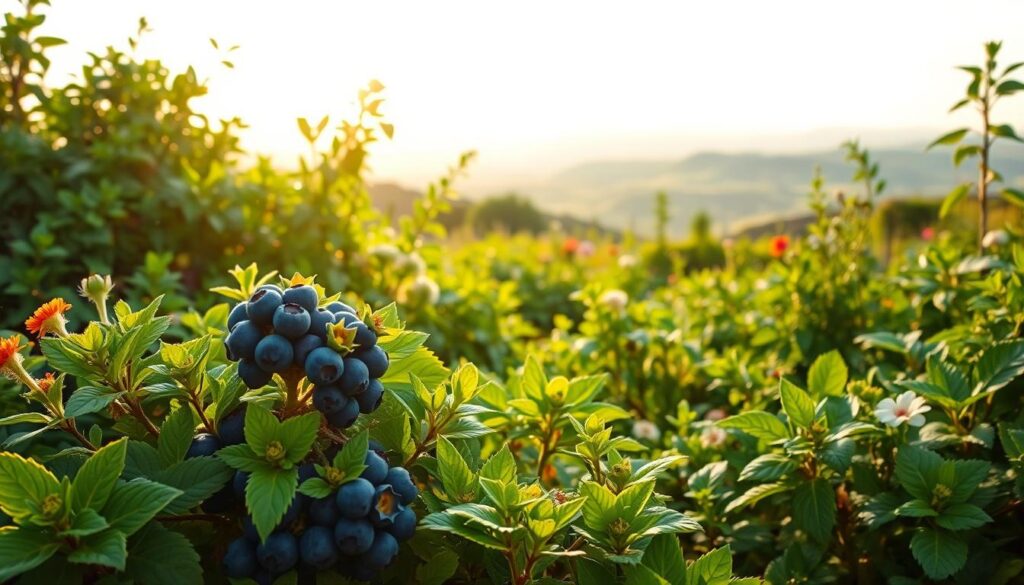
Ideal Soil Conditions for Blueberries
To cultivate healthy and productive blueberry plants, you need to understand their specific environmental needs. Blueberries thrive in conditions that promote growth and fruiting. The right soil quality and moisture levels play a crucial role in their development and overall yield.
Understanding Soil pH
One of the most important factors affecting blueberry growth is the soil pH. The ideal soil pH for blueberries ranges from 4.0 to 5.5, meeting their acidic soil requirements. This acidity allows the plant to absorb nutrients efficiently. Regular soil testing helps maintain this balance, ensuring that blueberry soil conditions remain favorable. If your soil leans too alkaline, consider incorporating sulfur or organic matter to adjust the pH.
Improving Drainage and Moisture
Blueberries prefer well-draining soil to avoid complications such as root rot caused bystanding water. Proper soil drainage is essential for the health of your plants. Enhancing the drainage capabilities of your soil can significantly improve moisture retention for blueberries. Utilizing organic materials, such as peat moss or compost, can help achieve this balance. Additionally, consistent and careful watering blueberries ensures that plants receive adequate moisture without becoming waterlogged. Regularly checking soil moisture levels will provide insight into your plants’ needs.

Best Companion Plants for Blueberries
When cultivating a garden with blueberries, selecting the right companion plants can enhance growth and protect your harvest. Integrating various herbs, flowering plants, and vegetables can create a thriving ecosystem that benefits blueberries while providing beauty and biodiversity to your garden.
Herbs to Plant Near Blueberries
Consider adding the best herbs for blueberry companion plants such as basil, mint, and chives. These herbs not only thrive in similar soil conditions as blueberries but also offer pest-repelling qualities. Herb choices for blueberries can effectively deter common pests and disease while promoting healthy growth of your berries.
Flowering Plants That Attract Pollinators
Flowering companions for blueberries play a vital role in attracting essential pollinators. Plants like redbud trees and flowering dogwoods bloom around the same time as blueberries, drawing bees and bumblebees to your garden. These pollinator plants for blueberry gardens significantly boost cross-pollination, thus increasing your berry yields.
Vegetables That Thrive Alongside Blueberries
You might think about incorporating vegetables to plant with blueberries such as lettuce, peppers, and radishes. Not only do these companion vegetables thrive well in similar conditions, but they also add to the diversity of your garden. The right mix of plants ensures a rich and fruitful growing environment, enhancing both the aesthetic and ecological balance of your garden.
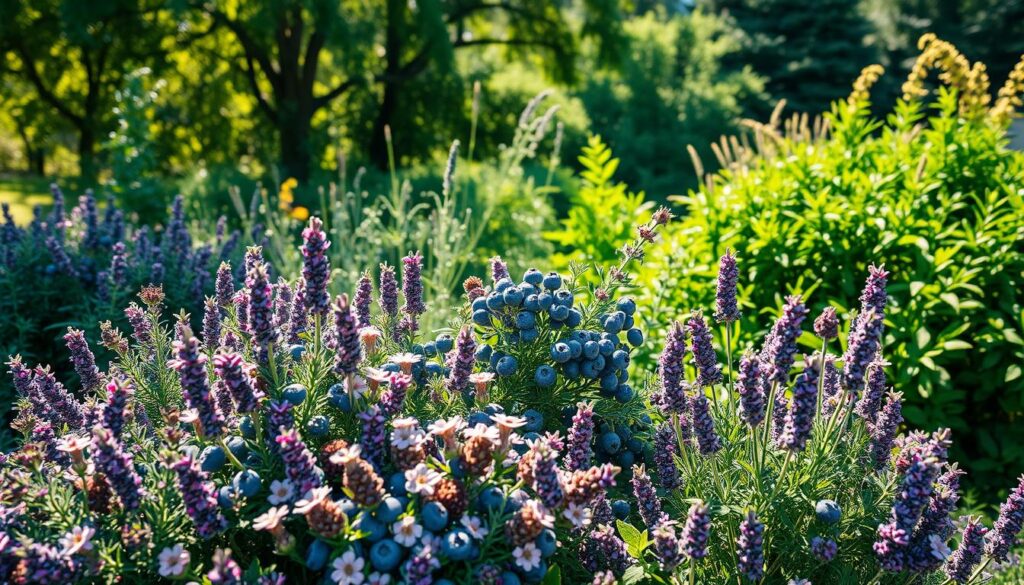
| Companion Plant Type | Plant Examples | Benefits |
|---|---|---|
| Herbs | Basil, Mint, Chives | Pest repellence, Similar care requirements |
| Flowering Plants | Redbud Trees, Flowering Dogwoods | Attract pollinators, Increase yields |
| Vegetables | Lettuce, Peppers, Radishes | Diverse growth, Aesthetic enhancement |
Herbs That Pair Well with Blueberries
Creating a fruitful garden with blueberries can be enhanced by choosing the right herbs as companions. Certain herbs, like basil, oregano, and mint, bring unique benefits to your blueberry plants while complementing their growth and flavor. Discover how these aromatic herbs can enrich your blueberry garden.
Basil: The Flavorful Companion
Basil thrives in acidic soil, making it an ideal partner for blueberries. The presence of basil can help repel pests that threaten your plants. The strong aroma of basil invites pollinators, which can boost overall fruit production. The basil benefits extend beyond pest control, as its delicious flavor enhances culinary dishes you create with your blueberries.
Oregano: A Flavor and Pest Control Ally
Oregano is another herb that matches well with blueberries, as it flourishes under similar growing conditions. The oregano benefits in blueberry gardens are significant, including attracting beneficial insects and providing a natural deterrent for harmful pests. Utilizing oregano as a companion plant not only supports the health of your blueberries but also adds delightful flavor to your meals.
Mint: A Vivacious Partner
Mint offers numerous advantages for blueberries, including pest repellence and attracting pollinators. While you should practice caution with mint due to its potential invasiveness, growing mint with blueberries can be highly beneficial when done thoughtfully. Consider planting mint in containers to manage its growth while still reaping its mint benefits for blueberries.
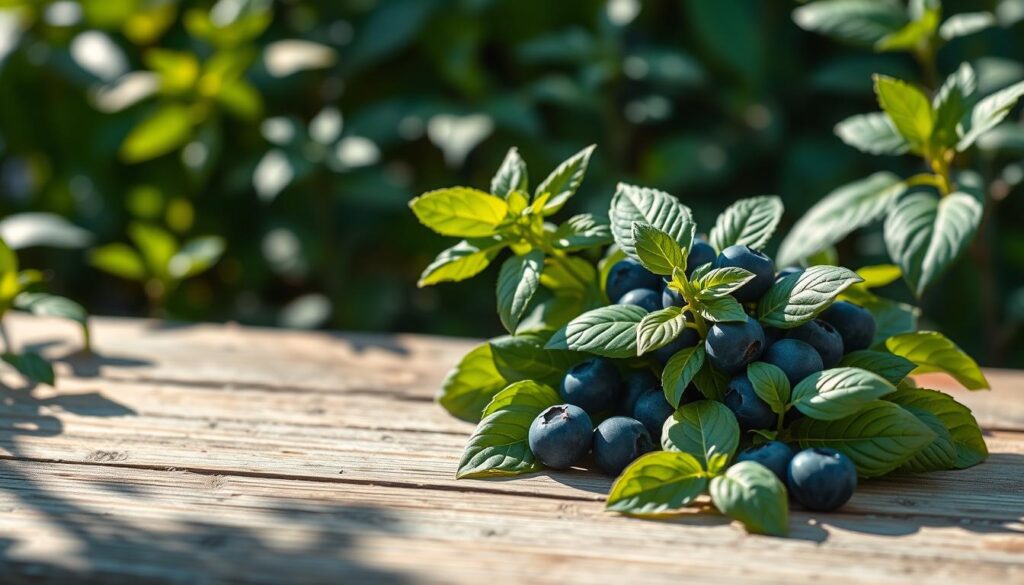
Vegetables to Consider Planting with Blueberries
When you think about companion vegetable planting with blueberries, several vegetable planting pairs can enhance your garden’s overall health and productivity. Consider the unique needs of these plants to create a harmonious environment that benefits both blueberries and their companions.
Lettuce: A Cool Companion
A lettuce variety with blueberries makes for an excellent pairing. Lettuce grows quickly and thrives in similar soil conditions as blueberries, making it an ideal choice. Its shallow roots mean it won’t compete heavily for nutrients, allowing both plants to flourish together in your garden.
Peppers: Growing Together Harmoniously
Peppers showcase a colorful addition to your blueberry patch, contributing to their overall aesthetic appeal. The peppers and blueberries companionship works well, as both plants prefer sunny locations and similar moisture requirements. This relationship allows them to coexist without competing for essential resources.
Radishes: Fast Friends in the Garden
Radishes with blueberries serve as a beneficial pairing due to their fast-growing nature. These compact vegetables do not require much space or nutrients, making them perfect companions. Radishes can draw up nutrients from deeper soil layers, enhancing the conditions for your blueberry plants and promoting overall health in the garden.

Attracting Beneficial Insects
Creating a thriving garden goes beyond growing desirable plants. It’s essential to focus on attracting pollinators and fostering an ecosystem that supports beneficial insects. By incorporating specific plants for beneficial insects into your garden, you can enhance the health of your blueberry plants and boost their yields. A diverse array of flowers contributes to drawing in bees, butterflies, and other vital pollinators.
Pollinator-Friendly Plants
To encourage beneficial insects, consider planting species like borage, bee balm, and lavender. These plants not only beautify your garden but also serve as a magnet for pollinators. Integrating these selections helps create a vibrant environment where you can witness insects working harmoniously to enhance your blueberry patch.
How to Create an Insect Habitat
Establishing insect habitats is straightforward. Tall plants and flowering shrubs provide shelter and staging areas for predatory insects, which play a crucial role in pest control. When you prioritize the inclusion of plants designed for attracting pollinators, you foster a tasteful sanctuary for encouraging beneficial insects. Strategically placing these plants throughout your garden creates a welcoming atmosphere that not only improves pollination but supports the delicate balance of your garden ecosystem.

Avoiding Bad Neighbors
Caring for your blueberry plants requires attention not only to their companions but also to those that may negatively affect their growth. Certain plants can be harmful plants near blueberries, leading to challenges in nurturing these delicious berries. Understanding which plants to keep at bay is crucial for healthy blueberry growth.
Plants to Keep Away from Blueberries
There are several incompatible plants for blueberries that should be avoided to prevent issues in your garden. Nightshades, such as tomatoes and potatoes, are notorious for competing with blueberries due to their preference for neutral soil—a condition blueberries do not thrive in. Additionally, heavy feeders like brassicas can deplete the essential nutrients blueberries need, leading to stunted growth.
Recognizing Negative Plant Interactions
Monitoring your garden closely is vital for identifying negative plant interactions. You might notice signs of nutrient competition, where some plants overshadow others. Keeping an eye out for pests that may be attracted to these harmful plants near blueberries can aid in addressing potential problems swiftly. Following these simple blueberry growing tips can lead to healthy, vibrant blueberry bushes that flourish in your garden.
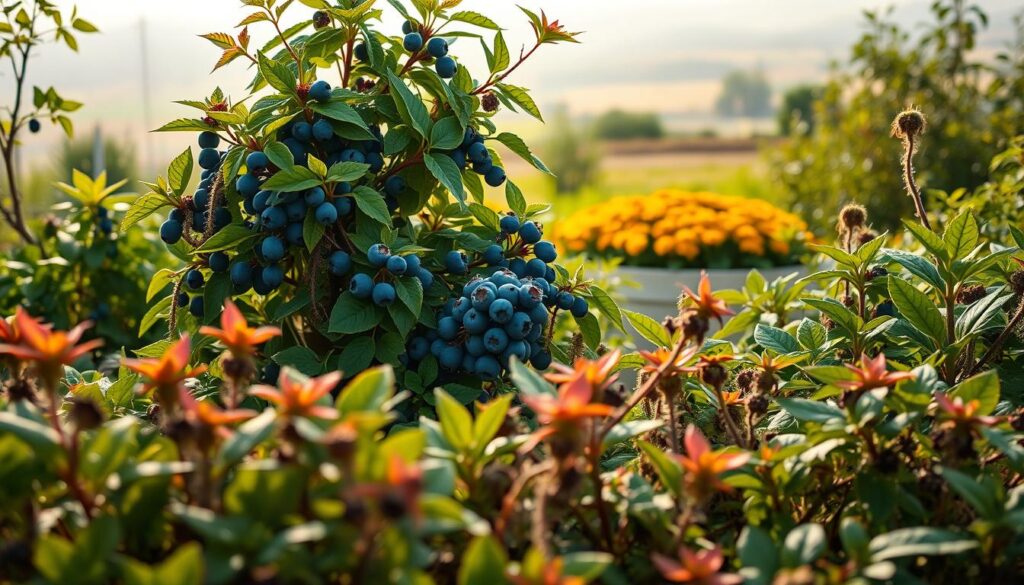
Seasonal Care for Companion Plants
Spring is a wonderful season for getting your garden ready for blueberries and their companions. This time of year is perfect for planting, ensuring that your herbs and flowers are established before the heat of summer. Following a seasonal planting guide is essential to ensure healthy growth and maximum benefits for both blueberries and their companions.
Spring Planting Tips
When considering spring planting for blueberries and companions, focus on a few key practices:
- Choose healthy, disease-free plants to start your garden.
- Ensure soil is adequately prepared, incorporating organic matter to enhance fertility.
- Plant herbs and perennial flowers early to provide support and protection for blueberries.
- Be mindful of spacing to allow for air circulation and sunlight absorption.
Summer Maintenance Strategies
With summer approaching, regular attention is necessary to ensure the health of your garden. Summer care for blueberry companions includes:
- Consistent watering to maintain moisture levels, particularly during dry spells.
- Monitoring for pests and diseases, which can affect both blueberry plants and companions.
- Pruning back unnecessary growth to encourage stronger, healthier plants.
- Checking soil pH regularly to ensure it remains within the ideal range for your blueberries.
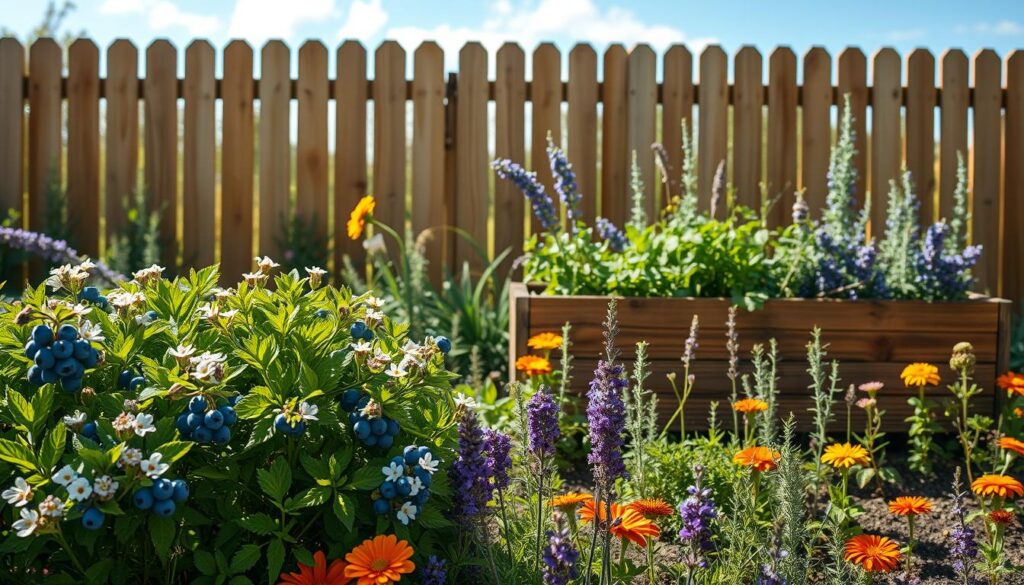
Increasing Yields with Companion Plants
Utilizing companion plants not only enhances the aesthetics of your garden but also increases yields significantly. By leveraging vertical strategies for blueberries, such as incorporating tall or climbing plants, you can make the most of your garden space. This approach allows you to cultivate multiple plant varieties in a confined area, ensuring that sunlight and nutrients reach all your plants effectively.
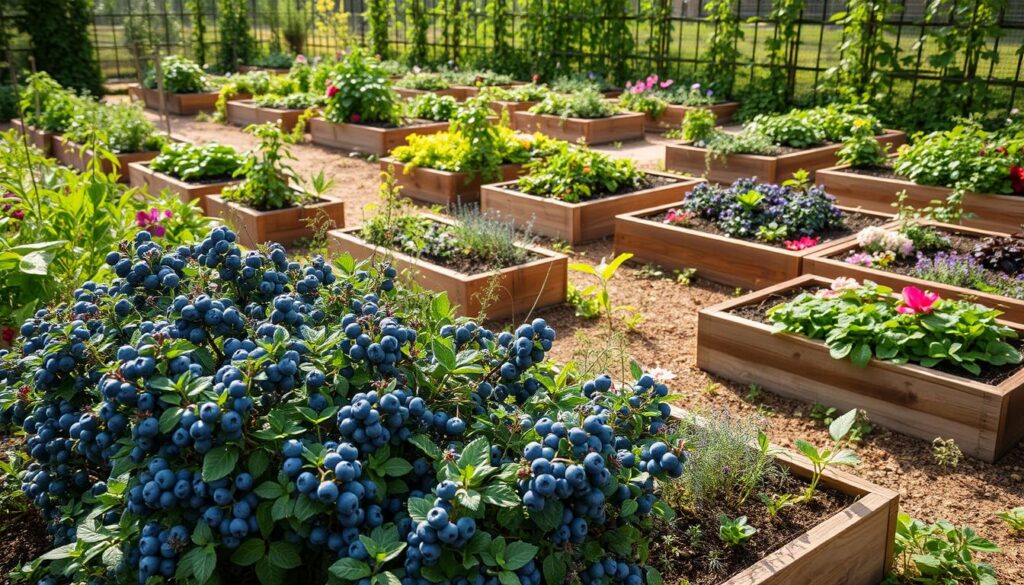
Timing is crucial when establishing your blueberry garden. Knowing the optimal planting times for blueberries ensures that your plants thrive and produce fruits throughout the season. For best results, align the timing of your seedlings with established blueberry plants. This practice prolongs harvests and maximizes garden space by generating a diverse array of produce all summer long.
Companion Planting in Container Gardens
Container gardening with blueberries presents a unique opportunity to curate a thriving mini-ecosystem right on your patio or balcony. To achieve successful growth, selecting the best container companions is essential. Choosing plants that share similar moisture and pH requirements will enhance your container gardening choices and promote healthy development. Larger containers are ideal as they provide sufficient space for root expansion, leading to better overall performance.
Best Practices for Container Companions
When engaging in container gardening with blueberries, consider the following practices:
- Choose large containers: This allows enough room for both blueberries and their companions to flourish.
- Group plants with similar needs: Ensure that the watering and sunlight requirements match for optimal growth.
- Regularly monitor soil moisture: Blueberries thrive in consistently moist yet well-draining soil.
Container-Specific Companion Choices
For effective container blueberry companions, consider these appealing options:
- Chives: These herbs not only complement blueberries in flavor but also deter harmful pests.
- Basil: Known for its aromatic qualities, basil thrives alongside blueberries, enhancing both growth and taste.
- Petunias: These striking flowers can attract pollinators while adding vibrant color to your container garden.
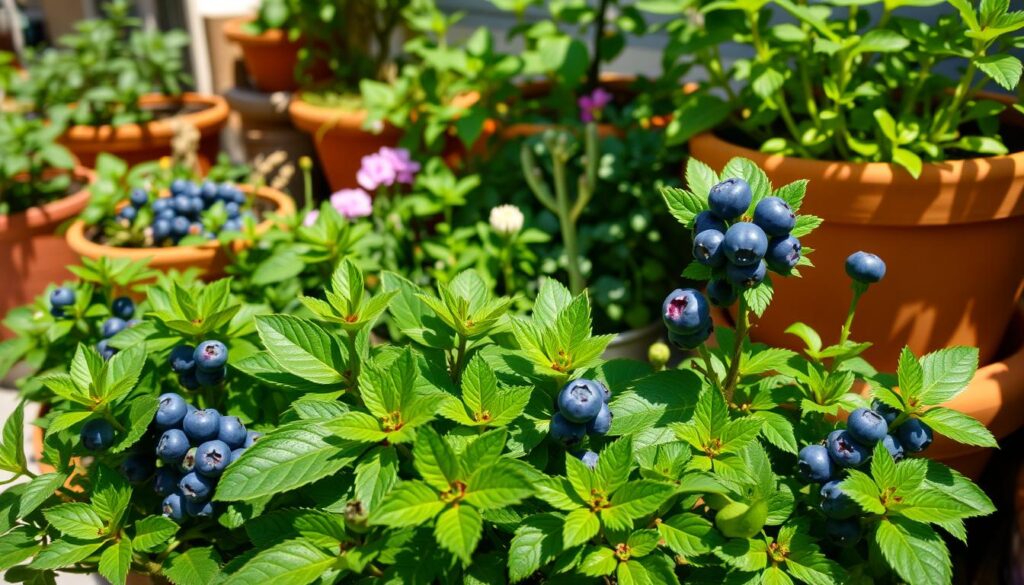
Maintaining Healthy Companion Plant Partnerships
To ensure your garden thrives, it is essential to be aware of signs of plant compatibility issues. As you nurture your blueberry plants alongside their companions, regular monitoring of companion plants can help identify stress or growth problems. A decline in vigor may signal that a reassessment of your garden layout is necessary.
Signs of Compatibility Problems
Keep an eye out for various indicators suggesting compatibility concerns among your plants. These can include:
- Stunted growth or decline in vigor
- Increased pest infestations
- Unusual leaf discoloration or wilting
Identifying these signs early allows you to take proactive steps towards maintaining a healthy relationship between your blueberry plants and their companions.
Adjusting Growing Conditions
If you observe any compatibility issues, adjusting plant conditions is crucial. Consider the following strategies:
- Modify watering practices to ensure adequate moisture
- Assess soil type and amend it to provide optimal nutrition
- Introduce organic mulch to retain moisture and improve soil health
Implementing these optimal gardening practices can significantly enhance overall plant health, fostering a thriving garden environment. By keeping a watchful eye and making necessary adjustments, your garden can flourish in harmony.
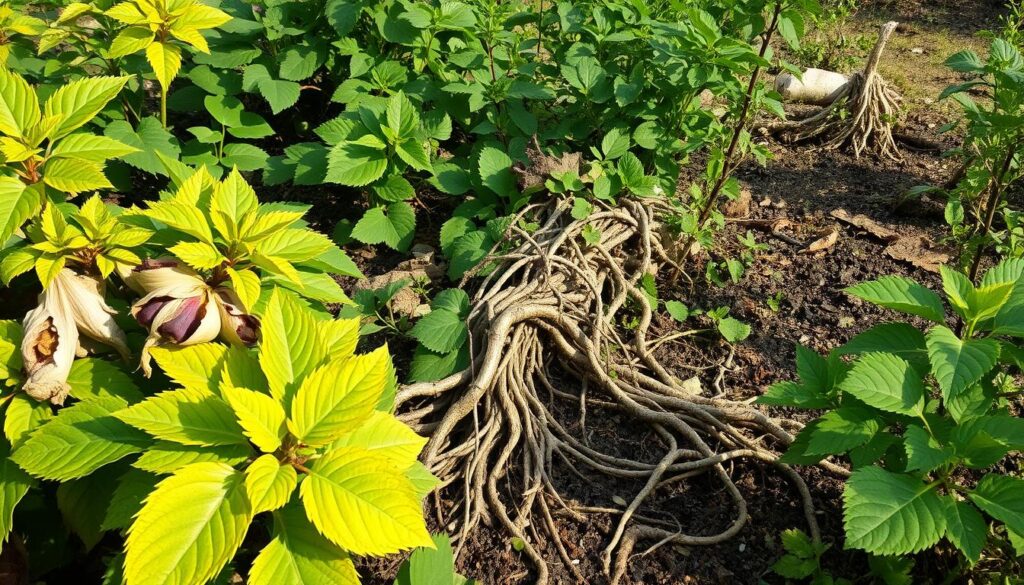
Seasonal Harvest: Companion Plant Considerations
Understanding the timing of your harvest can greatly influence the efficiency of your gardening efforts. By aligning the harvest of blueberries with their companion plants, you can simplify the process and minimize any waste. Using a reliable harvest timing guide helps you determine the right moment for both blueberries and their companions.
Timing Your Harvest with Companions
It is essential to consider the harvest timing of both blueberries and their accompanying plants. For instance, certain herbs and vegetables may mature around the same time as your blueberries. This synchronization allows you to maximize your yield without missing an optimal harvest window. Utilizing staggered harvesting techniques enables you to reap the rewards of your garden in phases, making each visit to your garden productive.
Benefits of Staggered Crop Harvesting
Implementing staggered harvesting enhances the overall productivity of your garden. This approach allows for a continuous supply of produce, ensuring that you enjoy fresh fruits and vegetables throughout the growing season. Additionally, staggered crops lead to reduced post-harvest waste, meaning that you can make the most of your efforts and resources. Each type of harvest has its unique requirements and benefits, ultimately contributing to a more sustainable gardening experience.
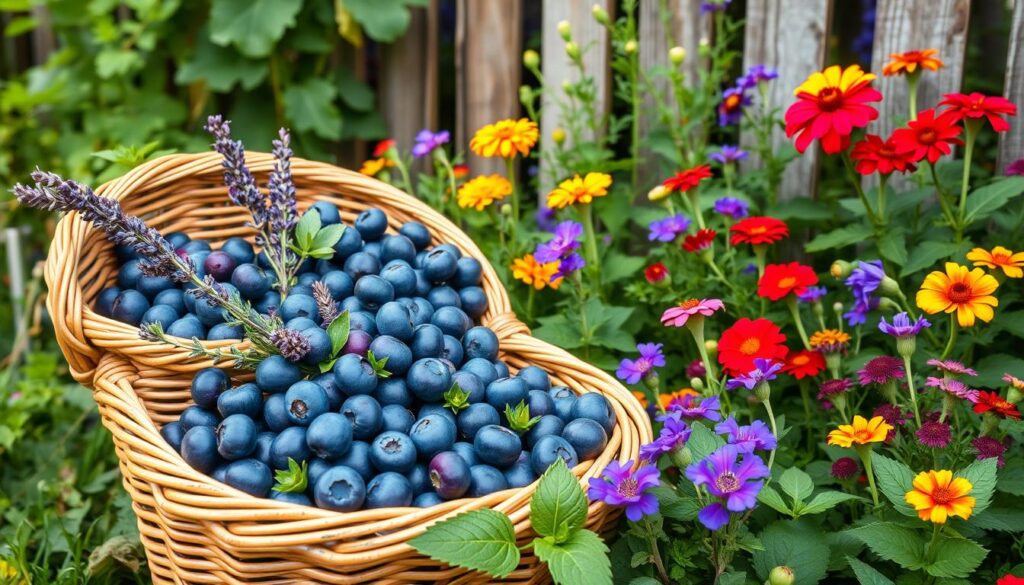
| Plant Type | Harvest Time | Companion Benefits |
|---|---|---|
| Blueberries | Mid to Late Summer | Flavors complement many dishes; attracts pollinators. |
| Basil | Late Spring to Early Summer | Deters pests from blueberries. |
| Lettuce | Early to Mid-Summer | Grows quickly, providing shade to blueberry roots. |
| Radishes | Early Summer | Fast-growing; opens space for blueberries to expand. |
Conclusion: A Vibrant Garden with Blueberries
As you reflect on the journey of selecting the best companions for blueberries, it’s clear that the right combinations can significantly elevate both beauty and productivity in your garden. Whether you’ve chosen vibrant herbs or flowering plants, these companions not only enhance yields but also help attract beneficial wildlife, enriching the ecosystem surrounding your blueberry bushes.
Recap of Top Companion Choices
This companion plant summary emphasized the importance of pairing blueberries with compatible neighbors. From fragrant basil to vibrant marigolds, the best companions not only coexist peacefully but can also uplift the growing conditions of your blueberries, making gardening a more rewarding experience.
Encouragement to Experiment and Enjoy Gardening
Gardening is fundamentally an art that invites you to explore and experiment with different plants. Don’t hesitate to test out new combinations and discover what works best in your unique environment. Embrace the process of experimenting with plants, and enjoy gardening as you cultivate a lush and fruitful sanctuary that you can cherish for years to come.



